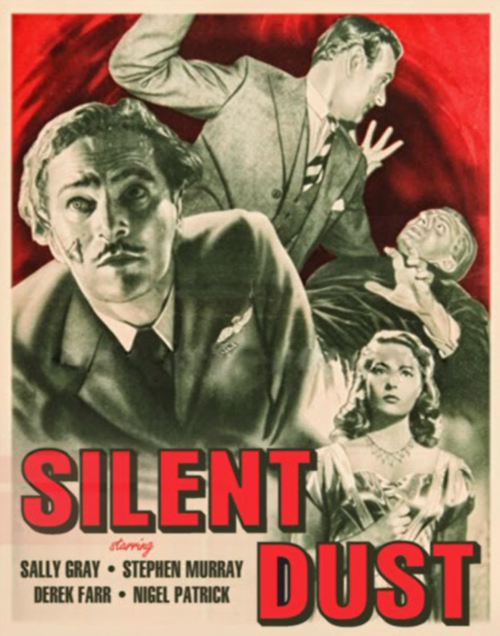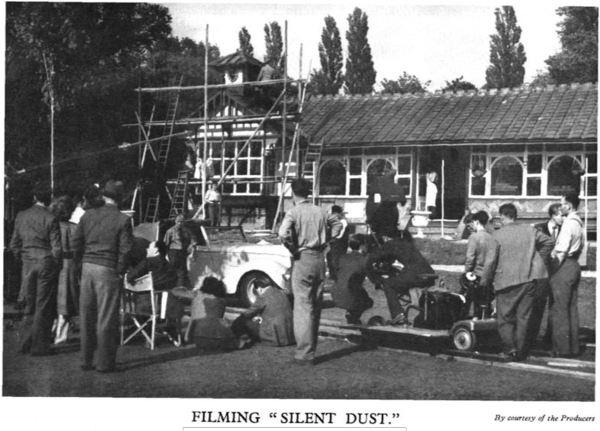
In the summer of 1948 Warner Brothers descended on the school to shoot a scene featuring a cricket pavilion, and the events were recorded in the September 1948 issue
of The Georgian.
Thursday 27th. May Corpus Christi. Just before lunch a gang of men from Warner Brothers started repainting the face of the cricket pavilion, in readiness for filming certain
scenes of "Silent Dust".
Tuesday 1st. June The pavilion looks gay in its new coat of paint, and the loads of gravel which Warner Brothers have showered on its paths make the scene brighter still.
The lower half of a clock now adorns the roof of the changing room, but this is shamelessly bogus: the body is of plywood and the works are imaginary.
Friday 11th. June Scaffolding appeared round the changing room of the pavilion. Not that it promises any further repair or decoration - one scene of the film has to show
the pavilion with work still in progress, and the scaffolding is the obvious way to suggest this. The erection is of poles roped together, since Warners' experts consider Surrey too rural an area
for tubular steel scaffolding. A glance at the work on the new refectory would have taught them better.
Thursday 17th. June "Man Bites Dog" is news, and so is "Film Studio Visits School." The pavilion scenes of "Silent Dust" were shot this afternoon. A few actors and some dozens
of officials and technicians arrived in the early afternoon with much cumbersome equipment, large vans and cars, a mobile canteen and even a miniature fire engine. Canvas seats - labelled: "Director",
"Continuity", "Mr. So-and-so" - dotted the field; the clock tower reappeared on the pavilion roof and a large inscribed plaque was rapidly fixed to the outside wall.
The boys saw nothing of the afternoon's work and of the (to a layman) incredible amount of repetition it involved. Workmen got busy with paintbrushes. A car, containing two stars and
a large dog, drove up to the pavilion and its occupants got out. The foreman came down to greet them; the man complained of the builders' slow progress and the foreman uttered words of explanation
and apology. The woman spoke banteringly of her companion's brusqueness and the couple drove off.
This was repeated and repeated till even the onlookers must have known the scene by heart. At the beginning of each shot an assistant stood before the camera, holding a board
inscribed with the name of the film and the number of the shot. He banged a clapper on the board to synchronise vision and sound, and moved nimbly away as action began. The Seniors were able to
watch the second scene ("some days later") during the after-tea recreation. The scaffolding had now been taken away and a decorative weather-vane surmounted the clock. We were not kept at a distance:
as long as we were quiet during the shooting and were not in front of the camera we could go where we liked, and the actors and technicians - a most friendly crowd - answered our many questions with
wonderful patience. Autographs were asked for and given, and amateur photographers had the time of their lives. Swimming and study at last put an end to the experience.
(A real clock tower was added to the cricket pavilion following the arson attack in 1987, but centrally mounted rather than over the changing room.)

Silent Dust was a low budget thriller filmed at Teddington Studios and released in February 1949. Directed by Lance Comfort and starring Sally Gray, Stephen Murray, Derek
Farr and Nigel Patrick. The screenplay was by Michael Pertwee (brother of Jon Pertwee of Doctor Who fame), adapted from his own successful stage play The Paragon.
A wealthy blind man is determined to build a cricket pavilion as a memorial to his dead son, who was killed in battle in World War II. Not long before the dedication ceremony is
to be held, the son shows up. It turns out that he wasn't killed in battle but deserted, and has become a blackmailer and a killer. He wants to get some money to start a new life, but his blind
father senses that something is wrong and sets out to find out what's going on.
The opening scene featuring the cricket pavilion can be viewed below. The whole film is available to view and download
free online here, and is also
available on DVD. As well as
the exterior backdrop of the pavilion in the opening scene look out for a model of the pavilion in the house.